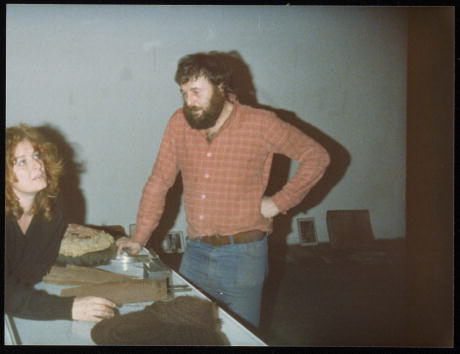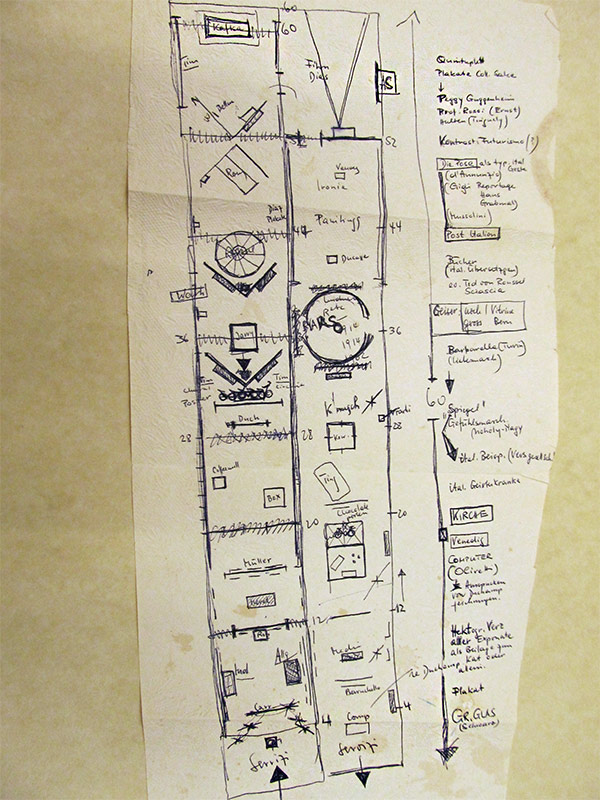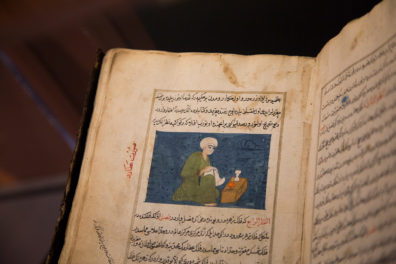
Harald Szeemann during the installation of documenta 5 in Kassel, Germany, 1972. Photo by Balthasar Burkhard. The Getty Research Institute, Harald Szeemann papers, 1892–2010
In 1969, Harald Szeemann declared independence. Resigning from the Kunsthalle Bern, the curator decided to pursue an independent career outside traditional art institutions and to personally assume every single decision and risk in his projects, from the very first concept to the final dismantling of the exhibition. He chose “From Vision to Nail” as one of the mottos for his newly established Agency for Intellectual Guest Labor, a one-man enterprise and a conceptual tool to identify his activity in the economic, political, and artistic fields.
“From Vision to Nail” could be easily applied as a catchphrase to the “Project Files” in his archive, which are now open for researchers at the Getty Research Institute. More than 500 boxes containing thousands of papers document Szeemann’s curatorial process for all of his more than 150 exhibitions, spanning a nearly 50-year career. Early notes, installation sketches, correspondence with artists, floor plans, catalog drafts, shipping documents, press clippings, and even parking tickets and telephone doodles will provide researchers a unique resource to plunge into the work of one of the most distinguished curators of the last decades, who has constantly questioned and reshaped the scope and meaning of exhibition-making within contemporary culture.

Collage by Harald Szeemann for the brochure of his first exhibition, Painter-Poets–Poet-Painters, 1957. The Getty Research Institute, Harald Szeemann papers, 1892–2010

Harald Szeemann and Ingeborg Lüscher during the installation of Szeemann’s exhibition on Monte Verità, Switzerland, 1979. Photographer unknown. The Getty Research Institute, Harald Szeemann papers, 1892–2010
From the very beginning of his career, in 1957, till the Biennales of the early 2000s, Szeemann kept copies of all documents for his projects. Previously scattered between Bern and Ticino, where Szeemann moved in the mid-1970s, the archive soon reached a monumental size, and was permanently housed in the mid-1980s on two floors of a former watch factory in Maggia, Switzerland. The fabbrica rosa (“pink factory”) served as the office for his ever-growing exhibition-making enterprise—and at the same time as a space in which the memory of his activities, and ultimately his historic legacy, took shape in first-person narration. In short, it was an all-embracing environment (a Gesamtkunstwerk, as Szeemann would have probably called it) in which the boundaries between professional and private life, daydreams and the highly influential public figure, were blurred and constantly redefined.
Originally ordered chronologically, the “Project Files” start with high school research and documents on Szeemann’s early theatrical career, and also include material related to other projects such as films, books, texts, seminars, lectures, awards ceremonies, exhibitions Szeemann co-curated or in which he was consultant, as well as unrealized projects. The processing of this main section of the Harald Szeemann archive, partially funded by the National Endowment for the Humanities, was a significant endeavor for the Research Institute. Five of us worked for an entire year to provide this material the best housing conditions and accessible finding aids, while preserving Szeemann’s original filing method. The Project Files complement the photograph series, which contains more than 40,500 photographic prints, negatives, slides, and transparencies.

Sketch for The Bachelor Machines at the 1975 Venice Biennale, Harald Szeemann. The Getty Research Institute, Harald Szeemann papers, 1892–2010

Sketch for the display of photos on one of the walls of the Museo Casa Anatta on Monte Verità, Switzerland, 1981, Harald Szeemann. The Getty Research Institute, Harald Szeemann papers, 1892–2010

Notes with different handwriting styles for Der Hang zum Gesamtkunstwerk, title of a 1983 exhibition, by Harald Szeemann. The Getty Research Institute, Harald Szeemann papers, 1892–2010

Harald Szeemann’s notes for the exhibition Der Hang zum Gesamtkunstwerk (1983), written on toilet paper. The Getty Research Institute, Harald Szeemann papers, 1892–2010
The team is already working on the artist files, which will be available in a year. They document Szeemann’s extensive correspondence with hundreds of artists and cultural figures and include an extensive collection of rare gallery ephemera such as invitation cards, press releases, and posters. The processing of the collection is scheduled to be complete by 2015, with the opening of the curator files along with smaller sections such as topical files and business papers. At that time, researchers will be able to study the archive itself not only as a historical record, but as one of the main projects and the outstanding cultural legacy of an art professional who was fundamental to the development and promotion of the art in the second half of the last century.

In the vaults: View of one portion of the processed Project Files at the Getty Research Institute

See all posts in this series »




Comments on this post are now closed.